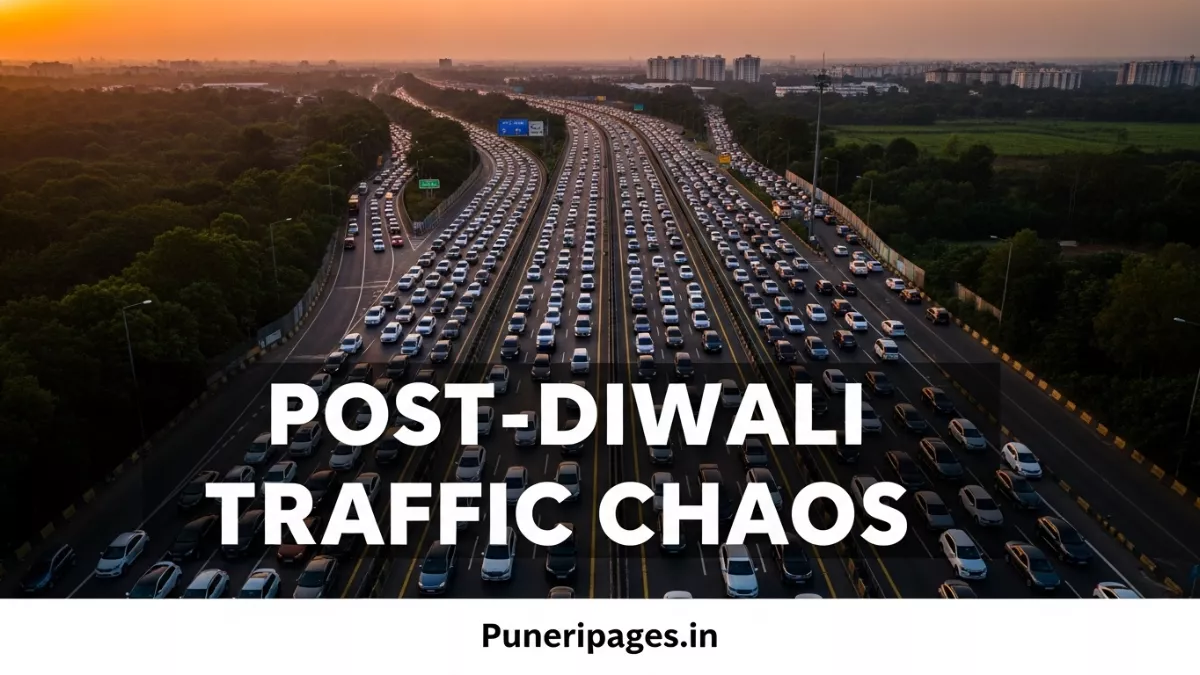
Pune–Mumbai Traffic Post-Diwali: Massive highway delays as commuters return to cities.
By Prashant for PuneriPages.in
As the Diwali holidays came to an end, thousands of commuters made their way back to major cities like Mumbai and Pune, resulting in massive traffic congestion along some of Maharashtra’s busiest highways. The Pune–Mumbai Expressway, Mumbai–Bengaluru Highway (NH48), and multiple connecting routes faced gridlocks for hours, causing delays, frustration, and longer travel durations for holiday travelers.
With an overwhelming number of citizens returning to their workplaces and educational institutions after week-long celebrations, the region witnessed one of the year’s biggest post-festival traffic surges.
Table of Contents
Pune–Mumbai Expressway Traffic Chaos: Long Queues and Delays
The Pune–Mumbai Expressway, known for its fast connectivity between two of Maharashtra’s largest cities, turned into a slow-moving corridor as vehicles crawled bumper-to-bumper. Toll plazas at Talegaon, Khalapur, and Urse witnessed long queues stretching over several kilometers.
Key Observations:
- Travel time increased from 2.5 hours to over 6 hours
- Major bottlenecks near Lonavala, Khandala Ghat, and Khopoli exit
- Increased number of private cars due to family travel
- Breakdowns and accidents intensifying traffic buildup
Authorities deployed additional highway patrol vehicles to manage lane discipline, yet the heavy surge made traffic control extremely challenging.
NH48: Mumbai–Bengaluru Highway Struggles Under High Traffic
The Mumbai–Bengaluru Highway (NH48), which also serves as an alternate route for Pune-bound traffic, experienced significant slowdowns, especially near:
- Katraj Ghat
- Shivapur Toll
- Baner/Mahalunge junction
- Navi Mumbai entry points
Truck movement, coupled with returning tourists, added pressure on road capacity, making sections almost standstill for prolonged periods.
Return Rush After Diwali: The Cause Behind the Jam
The Diwali season traditionally sees people traveling to their hometowns across Maharashtra, Karnataka, and Gujarat. As the holidays ended on Monday morning, a simultaneous return rush led to:
✅ Surge in intra-state and inter-state traffic
✅ Increased outstation travelers in private vehicles
✅ School re-openings and office resumptions post holidays
✅ Tourism peaks at hill stations like Lonavala and Mahabaleshwar
Officials estimate over 10 lakh vehicles used major highways during the extended weekend, marking an unusually high roadway load.
Highway Safety Concerns Amid Congestion
With so many vehicles on the move, road safety became a critical challenge.
🚫 Rash driving on narrow ghat sections
🚫 Sudden braking leading to minor collisions
🚫 Overloaded vehicles and fatigued drivers
🚫 Illegal parking on roadside shoulders
Emergency response teams handled multiple breakdowns and medical calls. Traffic police urged drivers to maintain lane discipline and avoid distraction-based driving.
Public Transportation Overloaded Too
Not just roads—MSRTC buses, railways, and even flight services reported overwhelming passenger demand.
🚌 State transport depots dispatched hundreds of extra buses
🚆 Major trains to Mumbai and Pune ran fully reserved weeks ahead
✈ Airports saw a spike in domestic flight occupancy
Still, private vehicles remained the most preferred mode for family travel, causing heavy road dependency.
Government and Police Traffic Management Measures
To handle the crisis, authorities executed crowd-management strategies including:
✅ Special traffic police deployment
✅ Coordination between MSRDC and Highway Traffic Control
✅ Diversions and advisory alerts on digital signage
✅ Social media updates about real-time road conditions
The police further requested travelers to avoid peak return hours or take early morning or late-night travel slots to reduce congestion.
Expert Prediction: Post-Festival Traffic to Continue for 2–3 Days
Transport analysts suggest that residual traffic may continue for:
📌 48 to 72 hours after the Diwali holiday period
Many college students and corporate employees extend their vacations, contributing to prolonged highway pressure.
Additionally, upcoming wedding season travel may also keep traffic levels high, particularly on weekends.
Commuter Voices: Delays and Difficulty
Travelers expressed frustration but acknowledged the seasonal rush:
“We expected rush, but not such a long jam. A simple 3-hour trip took 7 hours,” shared a Pune resident returning from Panvel.
“Even toll booths were stuck, kids got restless in the car,” said another commuter from Mumbai.
Despite the inconvenience, most drivers kept patience knowing the festive return rush is inevitable each year.
Digital Navigation Apps Fall Short Amid Gridlock
Commuters relying on apps like Google Maps and MapMyIndia observed rapidly changing travel times and unexpected route blockages. Some alternate routes suggested by apps also became congested as many drivers followed the same diversions.
Looking Ahead: Measures to Prevent Future Gridlocks
To tackle increasing festive-season road load, experts propose:
🚧 More toll-free lanes during peak seasons
🚧 Improved expressway monitoring with AI-based systems
🚧 Expansion of highway lanes at bottleneck zones
🚧 Promoting carpooling and public transportation
🚧 Better event-time travel advisory announcements
With rising vehicle ownership, long-term infrastructure development remains the key.
Travel Tips for Commuters Post-Diwali
To ensure smoother journeys:
✅ Start early morning or late night
✅ Choose public transport if possible
✅ Plan fuel and refreshment stops in advance
✅ Keep first-aid and water handy
✅ Avoid aggressive driving during jams
Being mindful can make travel less stressful and safer for everyone.
Conclusion
The Pune–Mumbai Expressway and major Maharashtra highways faced severe congestion as commuters returned after Diwali celebrations. With millions of citizens moving simultaneously, traffic delays became inevitable. Proper planning, better coordination, and smarter infrastructure solutions will be essential to prevent such gridlocks in future festive travel seasons.